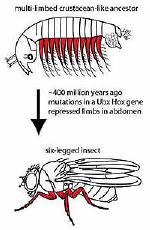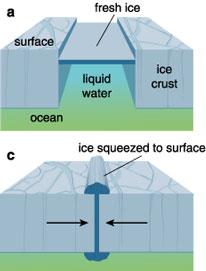 March 22: Microbes in the high atmosphere — Indian Astrophysicist Jayant V. Narlikar reports that atmospheric samples gathered at altitudes from 25 to 41 km continue to test positive for bacteria. The fact that the DNA sequences from the samples are not familiar weakens the argument that the bacteria could be earthly contaminants. Testing the bacteria for unearthly isotope ratios is planned for this summer in the Earth Sciences Dept at the ANU in Canberra. [Thanks, Chandra Wickramasinghe and Lawrence Hearn.]
March 22: Microbes in the high atmosphere — Indian Astrophysicist Jayant V. Narlikar reports that atmospheric samples gathered at altitudes from 25 to 41 km continue to test positive for bacteria. The fact that the DNA sequences from the samples are not familiar weakens the argument that the bacteria could be earthly contaminants. Testing the bacteria for unearthly isotope ratios is planned for this summer in the Earth Sciences Dept at the ANU in Canberra. [Thanks, Chandra Wickramasinghe and Lawrence Hearn.]
 Progress towards the vindication of panspermia, by N. C. Wickramasinghe et al., and "Microorganisms cultured from stratospheric air samples obtained at 41km," by M. Wainwright et al. — Two papers submitted to scientific journals in April, 2002.
Progress towards the vindication of panspermia, by N. C. Wickramasinghe et al., and "Microorganisms cultured from stratospheric air samples obtained at 41km," by M. Wainwright et al. — Two papers submitted to scientific journals in April, 2002.
 "Scientists find signs of life in cosmic sample," The Times of India, 22 Mar 2002.
"Scientists find signs of life in cosmic sample," The Times of India, 22 Mar 2002.
 An Atmospheric Test of Cometary Panspermia is the principal related CA webpage.
An Atmospheric Test of Cometary Panspermia is the principal related CA webpage.
 Bacteria or Viruses in the High Atmosphere — a section of the CA webpage, "Can the Theory Be Tested?".
Bacteria or Viruses in the High Atmosphere — a section of the CA webpage, "Can the Theory Be Tested?".
 March 18:
March 18:
Plant gene in a worm — Biologists in England and Ireland have found a gene that helps plants survive droughts also present in nematodes, where it performs a similar function. Examples like this one, a gene shared across different kingdoms, are consistent with the strong version of panspermia.
 John Browne et al. "Anhydrobiosis: Plant desiccation gene found in a nematode" [abstract], p 38 v 416, Nature, 7 Mar 2002.
John Browne et al. "Anhydrobiosis: Plant desiccation gene found in a nematode" [abstract], p 38 v 416, Nature, 7 Mar 2002.
 Viruses... is a related CA webpage. [Next-What'sNEW about HGT-Prev]
Viruses... is a related CA webpage. [Next-What'sNEW about HGT-Prev]
March 15, Houston TX:
The biological nature of the magnetites in ALH84001 is still in dispute, and contamination is still an issue. Today, at the Lunar and Planetary Science Conference, David McKay of NASA's Johnson Space Center showed that terrestrial contamination is an implausible source for the magnetites in the famous Martian meteorite. As for their biological nature, McKay's associate, Kathy Thomas-Keptra, compared rotating images of colored models of a truncated hex-octahedral magnetite crystal to electron microscopic images of magnetite crystals from the Mars meteorite. The match seemed perfect. But another report claimed that chemically produced magnetites match the model equally well. Thomas-Keptra rejoined that the synthetic ones are merely cubo-octahedrons, not the truncated hex-octahedral, biological kind. Later, McKay pointed out that in any case, scenarios for chemically producing magnetites do not resemble the plausible past environment of the Mars meteorite. No one admitted to changing his mind, but several speakers promised that additional analysis would be helpful.
 D. C. Golden et al. "Inorganic Formation of "Truncated Hexa-Octahedral" Magnetite: Implications for Inorganic Processes in Martian Meteorite ALH84001" [#1839], Lunar and Planetary Science XXXIII (2002).
D. C. Golden et al. "Inorganic Formation of "Truncated Hexa-Octahedral" Magnetite: Implications for Inorganic Processes in Martian Meteorite ALH84001" [#1839], Lunar and Planetary Science XXXIII (2002).
 David S. McKay et al. "Are Carbonate Globules, Magnetites, and PAHs in ALH84001 Really Terrestrial Contaminants?" [#1943], Lunar and Planetary Science XXXIII (2002).
David S. McKay et al. "Are Carbonate Globules, Magnetites, and PAHs in ALH84001 Really Terrestrial Contaminants?" [#1943], Lunar and Planetary Science XXXIII (2002).
 Kathie L. Thomas-Keprta et al. "Multiple Origins of Magnetite Crystals in ALH84001 Carbonates" [#1911], Lunar and Planetary Science XXXIII (2002).
Kathie L. Thomas-Keprta et al. "Multiple Origins of Magnetite Crystals in ALH84001 Carbonates" [#1911], Lunar and Planetary Science XXXIII (2002).
 No Knockouts in Martian Meteorite Showdown, by David L. Chandler, Sky and Telescope, 14 Mar 2002.
No Knockouts in Martian Meteorite Showdown, by David L. Chandler, Sky and Telescope, 14 Mar 2002.
 Geologist Recreates 'Life On Mars' Evidence In Her Laboratory, by SpaceDaily.com, 18 Mar 2002.
Geologist Recreates 'Life On Mars' Evidence In Her Laboratory, by SpaceDaily.com, 18 Mar 2002.
 Life on Mars! is a related CA webpage.
Life on Mars! is a related CA webpage.
March 12, Houston TX:
Mars — We're Back! This was the title of today's largest session at the 33rd Lunar and Planetary Society Conference in Houston. Impressive preliminary results and spectacular pictures were presented from the Thermal Emission Imaging System (THEMIS), the Gamma Ray Spectrometer (GRS), and the Mars Odyssey Radiation Environment Experiment (MARIE), observing programs aboard the Mars Odyssey Mission. But NASA told the standing-room-only audience that "Mars sample return has moved beyond the budget horizon."
 Mars Odyssey homepage
Mars Odyssey homepage
 "NASA Fixes Link on Mars Odyssey" [text], Los Angeles Times, 13 Mar 2002.
"NASA Fixes Link on Mars Odyssey" [text], Los Angeles Times, 13 Mar 2002.
 Life on Mars! is a related CA webpage.
More on amino acid chirality in Murchison — Veteran meteoriticist Sandra Pizzarello says that synchroton radiation could not produce the excess of L-amino acids observed in the Murchison meteorite — the proposed effect would be too weak. Her conclusion reinforces one by Stephen Mason, who wrote, in 1997, that the astronomical scenario for the process was entirely contrived. When asked if she could account for the phenomenon, Pizzarello answered no. The only known natural mechanism for producing exclusively L-amino acids is biological.
Life on Mars! is a related CA webpage.
More on amino acid chirality in Murchison — Veteran meteoriticist Sandra Pizzarello says that synchroton radiation could not produce the excess of L-amino acids observed in the Murchison meteorite — the proposed effect would be too weak. Her conclusion reinforces one by Stephen Mason, who wrote, in 1997, that the astronomical scenario for the process was entirely contrived. When asked if she could account for the phenomenon, Pizzarello answered no. The only known natural mechanism for producing exclusively L-amino acids is biological.
 S. Pizzarello, "The Chiral Amines of the Murchison Meteorite: a Preliminary Characterization" [#1233], Lunar and Planetary Science XXXIII (2002).
S. Pizzarello, "The Chiral Amines of the Murchison Meteorite: a Preliminary Characterization" [#1233], Lunar and Planetary Science XXXIII (2002).
 Amino Acid Asymetry... is a related CA webpage.
Is CIDA mis-calibrated? This is the suggestion of Don Brownlee, science director for the Stardust Mission. If so, there is reason to doubt the astonishing result of two years ago, when the German team managing the mass spectrometer aboard Stardust reported the detection of interstellar particles with molecules of 2000 atomic masses. Brownlee says that the calibration can be checked in 2004, when Stardust reaches comet Wild-2, where the nature of the particles is already presumed. If the instrument is not mis-calibrated, we hope the detection of large organic polymers in interstellar dust particles finally gets proper notice. [Thanks, Don Brownlee.]
Amino Acid Asymetry... is a related CA webpage.
Is CIDA mis-calibrated? This is the suggestion of Don Brownlee, science director for the Stardust Mission. If so, there is reason to doubt the astonishing result of two years ago, when the German team managing the mass spectrometer aboard Stardust reported the detection of interstellar particles with molecules of 2000 atomic masses. Brownlee says that the calibration can be checked in 2004, when Stardust reaches comet Wild-2, where the nature of the particles is already presumed. If the instrument is not mis-calibrated, we hope the detection of large organic polymers in interstellar dust particles finally gets proper notice. [Thanks, Don Brownlee.]
 ...Properties of Interstellar Dust... is the related CA webpage.
...Properties of Interstellar Dust... is the related CA webpage.
 CIDA miscalibrated? — Kissel replies, 4 Nov 2002.
CIDA miscalibrated? — Kissel replies, 4 Nov 2002. 
 33rd Lunar and Planetary Science Conference, 11-15 Mar 2002.
33rd Lunar and Planetary Science Conference, 11-15 Mar 2002.
 Preliminary Program in PDF with menu logic from program to sessions to abstracts.
Preliminary Program in PDF with menu logic from program to sessions to abstracts.
 March 11:
March 11:
Tardigrades in space? — Students in the NASA Student Involvement Program have proposed a project to fly tardigrades on the space shuttle, to see how well they can handle weightlessness. Tardigrades, or "water bears," are tiny animals with amazing survival capabilities. About 200 micrometers in length, they are barely visible without a microscope. Like all of life, they require water to metabolize, move, grow and multiply. Unlike other animals however, without water, a tardigrade curls into a ball called a "tun" and turns its metabolism off. Tuns have been known to survive for a hundred years, endure extreme heat (151 C), extreme cold (-200 C), freezing, thawing, changes in salinity, hard vacuum pressure, absence of oxygen, or X-rays hundreds of times more intense than other animals can. Normally, bacteria, not animals, are proposed for the space travelers of panspermia. But evolutionary biologist Jim Garey says, "If you had to pick an animal candidate, I'd pick a tardigrade." [Thanks, Marc Frantz.]
 Extreme Animals, by Leslie Mullen, NASA Astrobiology Institute, [publicised] 11 Mar 2002.
Extreme Animals, by Leslie Mullen, NASA Astrobiology Institute, [publicised] 11 Mar 2002.
 Introduction: More than Panspermia is a related CA webpage.
Introduction: More than Panspermia is a related CA webpage.
 Project BIOKIS is a related What'sNEW article, 18 May 2011.
Project BIOKIS is a related What'sNEW article, 18 May 2011.
March 2:
Correction — On 8 February, we reported on research that purportedly showed how simple mutations could cause a major change in arthropod body plans. We noted then that the change, loss of limbs, was not constructive. Today, with a copy of Nature in hand, we note that the term "simple mutations" is misleading.

 Ron Galant and Sean B. Carroll, "Evolution of a transcriptional repression domain in an insect Hox protein" [abstract] p 910-913 v 415, Nature, 21 Feb 2002:
Ron Galant and Sean B. Carroll, "Evolution of a transcriptional repression domain in an insect Hox protein" [abstract] p 910-913 v 415, Nature, 21 Feb 2002:
Galant and Carroll "identify a transcriptional repression domain in... the Drosophila Ultrabithorax (Ubx) protein [that is] is highly conserved... in other insects, but is absent from... other arthropods and onychophorans. The evolution of this domain may have facilitated the greater morphological diversification of posterior thoracic and anterior abdominal segments characteristic of modern insects." The principal conserved protein sequence is at least a dozen amino acids in length, and it is not the only one needed to repress transcription. Galant and Carroll do not claim that a simple mutation, or even a series of them, could have produced the conserved sequences. Rather, they conclude, "These studies suggest that a... domain in the Ubx protein of a common ancestor of crustaceans and insects was replaced...."
 Matthew Ronshaugen et al., "Hox protein mutation and macroevolution of the insect body plan" [abstract] p 914-917 v 415, Nature, 21 Feb 2002:
Matthew Ronshaugen et al., "Hox protein mutation and macroevolution of the insect body plan" [abstract] p 914-917 v 415, Nature, 21 Feb 2002:
To discover the evolutionary pathway to the insect body plan, Ronshaugen et al. modified the Ubx protein of the (possibly ancestral) brine-shrimp as follows: "...The 16 amino acids of the QA motif... were precisely deleted. [The modified proteins] contain combinations of precise alanine substitutions in the seven... serine and threonine residues." Even with this precision, the modified protein supressed thoracic limbs with only 75% effectiveness.

Both papers describe important and informative research. They do not show that simple mutations can produce evolutionary progress, nor even the loss of limbs that would be necessary to turn crustacean-like ancestors into insects.
 Biologists demonstrate macroevolution... — the original What'sNEW item, 8 Feb 2002.
Biologists demonstrate macroevolution... — the original What'sNEW item, 8 Feb 2002.
 Neo-Darwinism... is a related CA webpage.
Neo-Darwinism... is a related CA webpage.
 February 26:
February 26:
Recent floods on Mars. A team at the University of Arizona says that more water than the amount in Lake Erie rushed across Mars' surface within the past ten milion years. New photos from the Mars Global Surveyor spacecraft show few impact craters in the bed left by the flood; therefore it must have been recent. Volcanic fissures in the Athabasca Valles region are the likely source of the water — apparently the interior of Mars remains geologically active. Similar flood volcanism also occurred on Earth about ten milion years ago.
 Floods at Mars' Equator Are Recent..., by Lori Stiles, University of Arizona, 19 Feb 2002.
Floods at Mars' Equator Are Recent..., by Lori Stiles, University of Arizona, 19 Feb 2002.
 "Signs of Great Floods, on Mars" [text], The New York Times, 26 Feb 2002.
"Signs of Great Floods, on Mars" [text], The New York Times, 26 Feb 2002.
 Life on Mars! is the related CA webpage.
Life on Mars! is the related CA webpage.
 February 22:
February 22:
Common microbes survive pressure of 16,000 atmospheres. A team at the Carnegie Institution of Washington used diamond anvils to pressurize two bacterial species, E. coli, and the metal reducing Shewanella oneidensis. The bacteria endured pressures far beyond those of deep ocean trenches and in the deep crust, and subsequently exhibited metabolism. "The study suggests that as far as pressure goes, the subduction zones on Earth and deep water/ice structures, such as those found on the moons Europa, Callisto, and Ganymede, might be environments that could harbor life."
 Anurag Sharma et al., "Microbial Activity at Gigapascal Pressures" [abstract], p 1514-1516 v 295, Science, 22 Feb 2002.
Anurag Sharma et al., "Microbial Activity at Gigapascal Pressures" [abstract], p 1514-1516 v 295, Science, 22 Feb 2002.
 Jennifer Couzin, "Weight of the World on Microbes' Shoulders" [summary], p 1444-1445 v 295, Science, 22 Feb 2002.
Jennifer Couzin, "Weight of the World on Microbes' Shoulders" [summary], p 1444-1445 v 295, Science, 22 Feb 2002.
 Common microbes survive pressures equal to those found at 50 kilometers inside the Earth's crust, EurekAlert!, 21 Feb 2002.
Common microbes survive pressures equal to those found at 50 kilometers inside the Earth's crust, EurekAlert!, 21 Feb 2002.
 Microbes May Survive 50 Miles Down, SpaceDaily, 26 Feb 2002.
Microbes May Survive 50 Miles Down, SpaceDaily, 26 Feb 2002.
 Bacteria... is the related CA webpage.
Bacteria... is the related CA webpage.
 February 8:
February 8:
Biologists demonstrate macroevolution and thus answer a major challenge to darwinism by creationists. According to the press release, the scientists at the University of California, San Diego, "have uncovered the first genetic evidence that explains how large-scale alterations to body plans were accomplished during the early evolution of animals." Their experiment "shows how new animal body plans could arise from a simple genetic mutation...."
It sounds impressive, but it isn't. Reading on, we learn, "The scientists showed how modifications in the Hox gene Ubx... would have allowed the crustacean-like ancestors of Artemia, with limbs on every segment, to lose their hind legs...." So a simple mutation could have caused the loss of limbs. This result might count as an example of macroevolution, but not of macroevolutionary progress. For that, the result would have to be something like limbs on a creature than had none before. Such evolutionary steps have not been shown to be produced by simple mutations. We wish this challenge to darwinism were better recognized. [Thanks, Stan Franklin and Larry Klaes.]
 Hox protein mutation and macroevolution of the insect body plan [first paragraph], by Matthew Ronshaugen et al., Nature AOP, 6 Feb 2002
Hox protein mutation and macroevolution of the insect body plan [first paragraph], by Matthew Ronshaugen et al., Nature AOP, 6 Feb 2002
 Evolution of a transcriptional repression domain in an insect Hox protein [first paragraph], by Ron Galant and Sean B. Carroll, Nature AOP, 6 Feb 2002
Evolution of a transcriptional repression domain in an insect Hox protein [first paragraph], by Ron Galant and Sean B. Carroll, Nature AOP, 6 Feb 2002
 First Genetic Evidence Uncovered of How Major Changes in Body Shapes Occurred During Early Animal Evolution, UCSD Press Release, 6 Feb 2002
First Genetic Evidence Uncovered of How Major Changes in Body Shapes Occurred During Early Animal Evolution, UCSD Press Release, 6 Feb 2002
 Genetic Archeology Uncovers Early Animal Evolution, SpaceDaily, 6 Feb 2002
Genetic Archeology Uncovers Early Animal Evolution, SpaceDaily, 6 Feb 2002
 Correction... — a What'sNEW update of this story, 2 Mar 2002.
Correction... — a What'sNEW update of this story, 2 Mar 2002.
 Neo-Darwinism... is a related CA webpage.
Neo-Darwinism... is a related CA webpage.
 February 7:
February 7:
Life on Europa would benefit from tides. This is the conclusion of a team at the University of Arizona that has studied high-resolution images of Europa since late 1997. "The ocean is interacting with the surface," said UA's Richard Greenberg, professor of planetary sciences and member of the Imaging Team for NASA's Galileo Jupiter-orbiter spacecraft. "There is a possible biosphere that extends from way below the surface to just above the crust." [Thanks, Ron Baalke.]
 Richard Greenberg, "Tides and the Biosphere of Europa" [abstract], v 90 American Scientist, Jan-Feb 2002.
Richard Greenberg, "Tides and the Biosphere of Europa" [abstract], v 90 American Scientist, Jan-Feb 2002.
 Europa Might Foster Life, Says UA Member of Galileo Imaging Team, Richard Greenberg, University of Arizona, 7 Feb 2002.
Europa Might Foster Life, Says UA Member of Galileo Imaging Team, Richard Greenberg, University of Arizona, 7 Feb 2002.
 ...Life on Europa or Other Moons? is the CA webpage tracking What'sNEW there.
...Life on Europa or Other Moons? is the CA webpage tracking What'sNEW there.
 February 5:
February 5:
33rd Lunar and Planetary Science Conference, 11-15 March, Houston TX. Some very exciting developments have been announced here first in years past. Among the topics to be covered are Organic Material in Meteorites, Chondrites, Meteorites and IDPs, Iron Meteorites and Pallasites, CAIs, AOAs, and DIs, Achondrites, Lunar Regional Remote Sensing, Lunar Geophysics, Lunar Regolith, Lunar Impacts and Meteorites, Lunar Basalts, Martian Surface Chemistry and Terrestrial Analogs, Mars Volcanism, Mars Landers and Landing Sites, Mars Craters, Mars Tectonics, Mars: Geophysics and Geochemistry, Mars Polar Terrain and Processes, Mars: Oceans, Lakes, Valleys, and Other Flowing Things, Mars Remote Sensing, Mars Aeolian and Atmospheric Processes, Mars Future Instruments and Missions, Geology and Geophysics of Venus and Mercury, The Cratered Earth, Cratering Processes and Products, Interplanetary Dust and Micrometeorites, Planetary Formation and Early Evolution, and Isotopes, Gases, and Presolar Grains.
 33rd Lunar and Planetary Science Conference, 11-15 Mar 2002.
33rd Lunar and Planetary Science Conference, 11-15 Mar 2002.
 Preliminary Program in PDF with menu logic from program to sessions to abstracts.
Preliminary Program in PDF with menu logic from program to sessions to abstracts.
January 31: More about the changing dark spots on Mars. Over the past two-and-a-half years, the Mars Orbiter Camera has surveyed Mars' landscape in much greater detail than previous missions could. A Hungarian research team thinks that life causes the seasonal darkening of spots on some of Mars' sand dunes. Other experts disagree. This seasonal darkening was first publicised in September, 2001. [Thanks, Larry Klaes.]
 Some Mars Researchers See Life in Planet's Dunes, by Leonard David, Space.com, 30 Jan 2002.
Some Mars Researchers See Life in Planet's Dunes, by Leonard David, Space.com, 30 Jan 2002.
 Dark spots which spread every Martian spring... is CA's first notice of the phenomenon, 7 Sep 2001.
Dark spots which spread every Martian spring... is CA's first notice of the phenomenon, 7 Sep 2001.
 Life on Mars! is the related CA webpage.
Life on Mars! is the related CA webpage.
 January 16:
January 16:
Methanogenic archaea thrive on inorganic rock 200 meters deep in a hot spring in Idaho. "Frank Chapelle of the US Geological Survey in Columbia, South Carolina, and his colleagues identified the microbes living there from their DNA sequences. They were shocked to find that more than 90% of the organisms in the spring were methane-producing Archaea." If methanogens can thrive in that inhospitable environment, perhaps they could thrive underground on other planets as well. If so, they might account for methane in the atmospheres of apparently lifeless planets. Astrobiologist Richard Taylor of the Probability Research Group in London commented, "It's life on the surface that's unusual." [Thanks, Ron Baalke.]
 Frank Chapelle et al., "A hydrogen-based subsurface microbial community dominated by methanogens" [abstract], p 312-315 v 415 Nature, 17 Jan 2002.
Frank Chapelle et al., "A hydrogen-based subsurface microbial community dominated by methanogens" [abstract], p 312-315 v 415 Nature, 17 Jan 2002.
 Life, as it was in the beginning? — A new type of Earth ecosystem could be found on other planets, by John Whitfield, Nature News Service, 17 Jan 2002.
Life, as it was in the beginning? — A new type of Earth ecosystem could be found on other planets, by John Whitfield, Nature News Service, 17 Jan 2002.
 UMass researchers find environment on Earth that mimics Mars geochemically and supports ancient life form, EurekAlert!, 16 Jan 2002.
UMass researchers find environment on Earth that mimics Mars geochemically and supports ancient life form, EurekAlert!, 16 Jan 2002.
 Bacteria... is a related CA webpage.
Bacteria... is a related CA webpage.
 January 9, 2002:
January 9, 2002:
Bacteria sent into space survive. "A team led by Gerda Horneck of the German Aerospace Centre in Cologne ...conducted a series of remote-controlled experiments aboard Russian Foton satellites in 1994, 1997 and 1999. Their research, published in December's issue of ...Origins of Life and Evolution of the Biosphere, provides powerful backing for the panspermia lobby." [Thanks, Jim Galasyn.]
 "Likelihood of Transport of Life between the Planets of Our Solar System," conference presentation by Gerda Horneck, [p 231-236], First Steps in the Origin of Life in the Universe, Chela-Flores, J., Owen, T., Raulin, F. (eds), 2001.
"Likelihood of Transport of Life between the Planets of Our Solar System," conference presentation by Gerda Horneck, [p 231-236], First Steps in the Origin of Life in the Universe, Chela-Flores, J., Owen, T., Raulin, F. (eds), 2001.
 Bugs could travel in comfort aboard meteorites, by Anil Anathaswamy, New Scientist, 9 Jan 2002.
Bugs could travel in comfort aboard meteorites, by Anil Anathaswamy, New Scientist, 9 Jan 2002.
 Bacteria... is a related CA webpage.
Bacteria... is a related CA webpage.